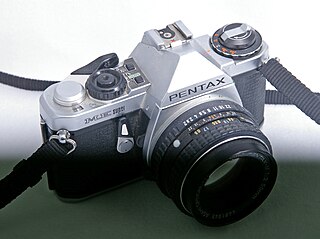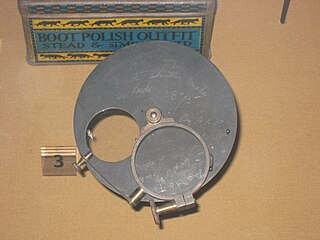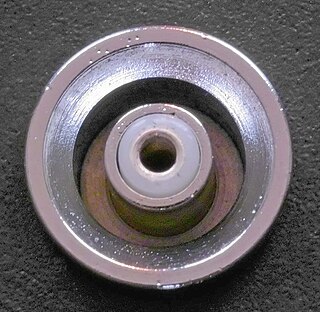Related Research Articles

A reciprocating engine, also often known as a piston engine, is typically a heat engine that uses one or more reciprocating pistons to convert high temperature and high pressure into a rotating motion. This article describes the common features of all types. The main types are: the internal combustion engine, used extensively in motor vehicles; the steam engine, the mainstay of the Industrial Revolution; and the Stirling engine for niche applications. Internal combustion engines are further classified in two ways: either a spark-ignition (SI) engine, where the spark plug initiates the combustion; or a compression-ignition (CI) engine, where the air within the cylinder is compressed, thus heating it, so that the heated air ignites fuel that is injected then or earlier.

A twin-lens reflex camera (TLR) is a type of camera with two objective lenses of the same focal length. One of the lenses is the photographic objective or "taking lens", while the other is used for the viewfinder system, which is usually viewed from above at waist level.

In photography, shutter speed or exposure time is the length of time that the film or digital sensor inside the camera is exposed to light when taking a photograph. The amount of light that reaches the film or image sensor is proportional to the exposure time. 1⁄500 of a second will let half as much light in as 1⁄250.

A four-strokeengine is an internal combustion (IC) engine in which the piston completes four separate strokes while turning the crankshaft. A stroke refers to the full travel of the piston along the cylinder, in either direction. The four separate strokes are termed:
- Intake: Also known as induction or suction. This stroke of the piston begins at top dead center (T.D.C.) and ends at bottom dead center (B.D.C.). In this stroke the intake valve must be in the open position while the piston pulls an air-fuel mixture into the cylinder by producing a partial vacuum in the cylinder through its downward motion.
- Compression: This stroke begins at B.D.C, or just at the end of the suction stroke, and ends at T.D.C. In this stroke the piston compresses the air-fuel mixture in preparation for ignition during the power stroke (below). Both the intake and exhaust valves are closed during this stage.
- Combustion: Also known as power or ignition. This is the start of the second revolution of the four stroke cycle. At this point the crankshaft has completed a full 360 degree revolution. While the piston is at T.D.C. the compressed air-fuel mixture is ignited by a spark plug or by heat generated by high compression, forcefully returning the piston to B.D.C. This stroke produces mechanical work from the engine to turn the crankshaft.
- Exhaust: Also known as outlet. During the exhaust stroke, the piston, once again, returns from B.D.C. to T.D.C. while the exhaust valve is open. This action expels the spent air-fuel mixture through the exhaust port.

In photography, flash synchronization or flash sync is the synchronizing the firing of a photographic flash with the opening of the shutter admitting light to photographic film or electronic image sensor.

The valve gear of a steam engine is the mechanism that operates the inlet and exhaust valves to admit steam into the cylinder and allow exhaust steam to escape, respectively, at the correct points in the cycle. It can also serve as a reversing gear. It is sometimes referred to as the "motion".
The science of photography is the use of chemistry and physics in all aspects of photography. This applies to the camera, its lenses, physical operation of the camera, electronic camera internals, and the process of developing film in order to take and develop pictures properly.

A linear actuator is an actuator that creates linear motion, in contrast to the circular motion of a conventional electric motor. Linear actuators are used in machine tools and industrial machinery, in computer peripherals such as disk drives and printers, in valves and dampers, and in many other places where linear motion is required. Hydraulic or pneumatic cylinders inherently produce linear motion. Many other mechanisms are used to generate linear motion from a rotating motor.

In photography, a shutter is a device that allows light to pass for a determined period, exposing photographic film or a photosensitive digital sensor to light in order to capture a permanent image of a scene. A shutter can also be used to allow pulses of light to pass outwards, as seen in a movie projector or a signal lamp. A shutter of variable speed is used to control exposure time of the film. The shutter is constructed so that it automatically closes after a certain required time interval. The speed of the shutter is controlled either automatically by the camera based on the overall settings of the camera, manually through digital settings, or manually by a ring outside the camera on which various timings are marked.

The Bulb setting on camera shutters is a momentary-action mode that holds shutters open for as long as a photographer depresses the shutter-release button. The Bulb setting is distinct from shutter's Time (T) setting, which is an alternate-action mode where the shutter opens when the shutter-release button is pressed and released once, and closes when the button is actuated again.

The Canon EF is a manual focus 35mm single-lens reflex camera produced by Canon between 1973 and 1978. It was compatible with Canon's FD-mount lenses. The EF was built as an electro-mechanical version of Canon's top-of-the line wholly mechanical Canon F-1. The shutter is mechanical at all speeds ½ second and faster, but at 1 second and longer the shutter is all electronically controlled, allowing AE exposures from 1/1000 to 30 seconds. The EF shares the F-1's rugged construction and tough metal body. Unlike the F-1, the EF does not support any motor drive for film transport. Neither does it provide any interchangeable viewfinder.
Cylinder head porting refers to the process of modifying the intake and exhaust ports of an internal combustion engine to improve their air flow. Cylinder heads, as manufactured, are usually suboptimal for racing applications due to being designed for maximum durability. Ports can be modified for maximum power, minimum fuel consumption, or a combination of the two, and the power delivery characteristics can be changed to suit a particular application.

The Kodak Retina Reflex is a discontinued series of four single-lens reflex cameras made by Kodak in Germany between 1957 and 1974, as part of the Kodak Retina line of 35mm film cameras.

The Bessamatic and Ultramatic were lines of 35mm SLR cameras made by Voigtländer in the 1960s, featuring a selenium meter. It uses a leaf shutter, similar to competing SLR cameras manufactured by Kodak and Zeiss Ikon in Germany, rather than the focal plane shutter almost universally adopted by Japanese SLRs such as the contemporary Nikon F and Pentax Spotmatic. The Ultramatic was released in 1963, which used the same lens mount and added a shutter-priority autoexposure mode.

An expansion valve is a device in steam engine valve gear that improves engine efficiency. It operates by closing off the supply of steam early, before the piston has travelled through its full stroke. This cut-off allows the steam to then expand within the cylinder. This expanding steam is still sufficient to drive the piston, even though its pressure decreases as it expands. As less steam is supplied in the shorter time for which the valve is open, use of the expansion valve reduces the steam consumed and thus the fuel required. The engine may deliver two-thirds of the work, for only one-third of the steam.

A Prontor-Compur connection is a standard 3.5 mm (1/8") electrical connector used in photography to synchronize the shutter to the flash.

A lens board or lensboard is a photographic part used for securing a lens to the front standard of a large format view camera. The lens board itself is usually flat, square, and made of metal, wood, or plastic. The lens board will have a hole of various diameters drilled dead center on the board. A lens board typically varies between 1 and 4 millimeters in thickness. The overall size and shape of the lens board depends on the brand of camera and film format used. Some cameras will use 2 to 4 screws to secure the lens board to the front standard of the view camera, most commonly however, the lens board will be secured by one or more locking levers or tabs to allow tool-less removal of the lens board. The rear surface of a lens board is usually painted matte black to keep light entering the camera through the lens during exposure from reflecting off the surface and interfering with the projected image.

The Pentax 6×7 is a SLR medium format system film camera for 120 and 220 film, which produces images on the film that are nominally 6 cm by 7 cm in size, made by Pentax. It originally debuted in 1965 as a prototype dubbed the Pentax 220. Since then, with improvements, it was released in 1969 as the Asahi Pentax 6×7, as well as the Honeywell Pentax 6×7 for the United States import market. In 1990, it received a number of minor engineering updates and cosmetic changes and was renamed as the Pentax 67.
Jacobs Vehicle Systems, Inc. is an American company that engineers, develops and manufacturers commercial vehicle retarding and valve actuation technologies. The company produces light-duty, medium-duty, and heavy-duty engine brakes, recreational vehicle exhaust brakes, aftermarket parts and tune-up kits to heavy-duty diesel engine manufacturers in its domestic market in America, as well as in Asia and Europe.

Friedrich Deckel GmbH, also known as F.Deckel, was a German company founded by Friedrich Deckel and Christian Bruns in Munich as Bruns & Deckel in 1903. Its most famous product is the Compur line of leaf shutters used on many photographic lenses starting from 1911. Bruns and Deckel previously had worked together at C. A. Steinheil & Söhne; Bruns was an inventor responsible for developing leaf shutters while Deckel was a laboratory mechanic.
References
- ↑ Klaus-Eckard Riess. "Up and Down with Compur - The development and photo-historical meaning of leaf shutters". www.kl-riess.dk. Archived from the original on 3 September 2019.
S K Grimes (1990). "Compound Shutters for Large Format Photographers". www.skgrimes.com. Archived from the original on 22 February 2007.